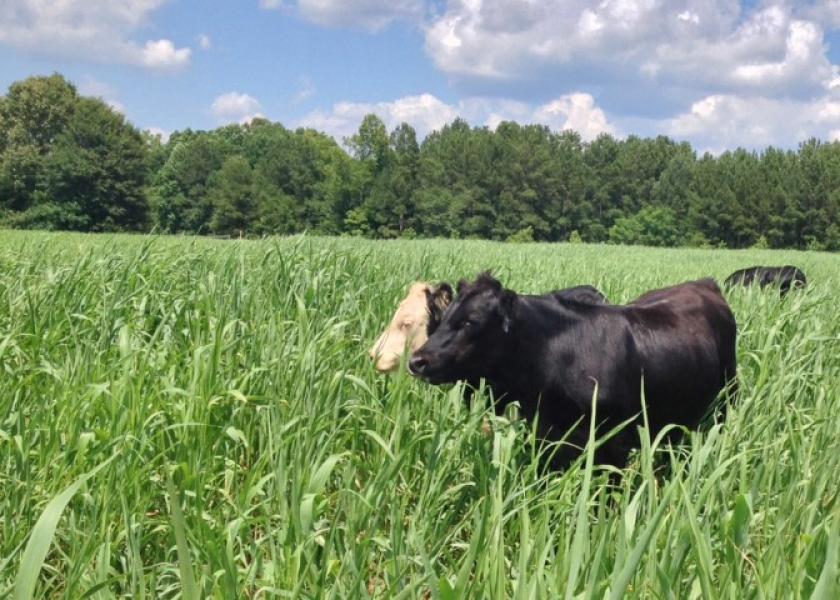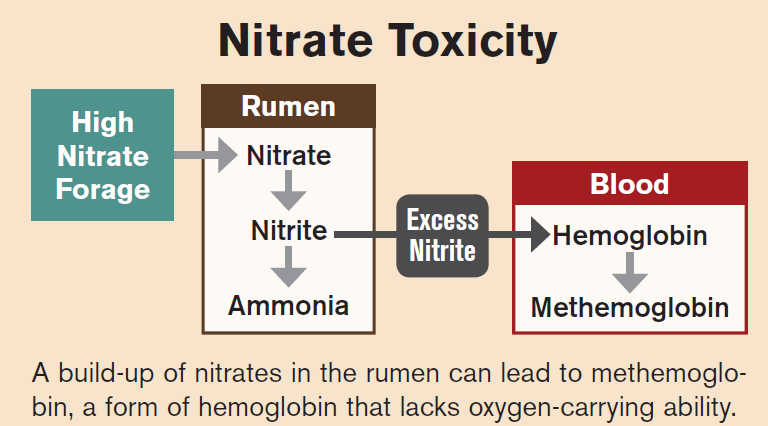Get to Know Nitrate Toxicity

A beef producer’s worst nightmare is walking out into a pasture or pen and seeing dead cattle. After the shock of seeing the animals lost, diagnosing the cause is important to avert further losses.
Rarely will the cause be forage, but weird circumstances can arise particularly in times of drought says Michelle Arnold, a ruminant extension veterinarian with the University of Kentucky.
“We don’t have a lot of problem with forages because cattle are made to graze,” Arnold says.
A possible disorder incurred during drought comes in the form of nitrate poisoning. Excessive nitrogen fertilization and reduced growth rates can also bring on more incidence of the toxin.
High nitrates are witnessed in a variety of forages including: sorghum, sorghum Sudan hybrids, Johnsongrass, millet, pearl millet, rye, wheat, oats, corn stalks, sugar beet tops, turnips and kale.
Cattle can handle certain amounts of nitrates says Arnold. When eating forage with smaller doses of nitrates the rumen will convert the nitrate to nitrite and then ammonia which will eventually be protein.
For nitrate toxicity to occur there must be excess pooling of the nitrate in the plant. It starts in the roots and works its way up the stem. In plants with larger stems like sorghum and corn this can particularly be a problem.
The buildup of nitrates makes it difficult for the rumen to convert the nitrite.
“You’ve got this excess nitrite and it combines with hemoglobin to form methemoglobin,” Arnold says.
Hemoglobin carries oxygen in the blood stream to body tissues, while methemoglobin is a form of hemoglobin that doesn’t carry oxygen.
“Now you’ve got a situation where you don’t have any oxygen carrying capacity in the blood,” Arnold adds.
Nitrates can be found in grazed forages and stored forms like hay.
Signs of nitrate poisoning are weak and wobbly cattle with mucous membranes that tend to be a muddy, chocolate color.
Arnold cautions that cattle suffering from nitrate toxicity can collapse and die quickly. “Any cows that do survive usually abort because the fetus didn’t get enough oxygen,” she adds.
Treatment is possible with methylene blue dye; however there is a 180 day withholding period before those animals can enter the meat supply.
Before even feeding cattle suspect forage Arnold recommends having it tested for nitrate levels.
Greg Highfill with Oklahoma State University Extension also has some experience dealing with high nitrate levels in western Oklahoma where grazing and haying forage sorghum is common. During years of drought county offices will see triple the amount of feedstuffs brought in for sampling.
“It is critical that beef producers know that nitrate level of the hay they are buying or baling to assure the health of their herd,” Highfill says.
If the test determines the pasture or stored forages are high in nitrates there are options.
First and foremost do not let pregnant cows have access to high nitrate forage. “A lot of times pregnant cows won’t show any clinical signs but they will abort,” Arnold says.
Instead, graze open replacement heifers or stocker cattle on the risky forage to eliminate the threat of abortion.
“They can develop a tolerance to nitrates overtime,” Arnold says. “They can handle some of it. It is that really rapid, fast formation of excess nitrate that causes problems.”
Diluting out the high nitrate forage is another alternative. Producers can feed hay from a low nitrate source first or mix it with the potentially toxic forage. Feeding grain helps too.
“Increasing the total energy of the ration, so feeding some grain can help them tolerate the higher nitrates,” Arnold relates.
Cattle do not need sudden changes, so gradually introducing them to high nitrate forages will give their rumen flora time to adapt.
A last resort may be a feed additive like Bova-Pro. The active ingredient is Propionibacterium acidipropionici, a bacterial strain that reduces both nitrate and nitrite levels in the rumen.
“It is not a cure-all but can be an important management tool when feeding hay that is moderately high in nitrates,” Highfill says. “The product must be fed at least 10 days prior to high nitrate feed exposure to ensure the bacteria are well established in the rumen.”
Additional Resources:








